Best Flood Barriers for Disasters and Emergencies
This is an update on the best flood barriers with tips on flood prevention from our stormwater scientist. We’ll continue to update as new flood barriers are available and with even more flooding mitigation tips.
In times of unexpected deluges and rising waters, safeguarding lives and property becomes paramount. When faced with the destructive force of floods, having a reliable and effective flood barrier can mean the difference between chaos and calm, devastation and protection. Making a plan and picking the best flood barriers for your situation ahead of time is key.
There are plenty of types and brands of flood barriers to pick from. This is where we come in. We’ve researched the best flood barriers, put them to the test, and now the results are in: the best flood barrier, the best sandbags, and a whole home option. If you want to protect your property quickly and effectively, one of our picks will keep you dry.
Contents (Jump to a Section)
The Best Flood Barrier
Quick Dam Flood Barrier
Easy to Use, Fast Deployment, and Effective
These water-activated pigs are great at quickly fortifying doorways from rising water.
*Price at time of publishing; check for price changes or sales.
Quick Dam is the biggest name in flood protection with products ranging from door barriers all the way up to total home solutions. This little absorbent pig can be found in most hardware stores and online making them convenient to pick up.
Even more convenient is their deployment- they stay relatively flat until water hits them where they start to absorb and take shape. Once they absorb 8 gallons of water, they measure 3.5″ tall each.
Here is how the Quick Dam measures up:
- 3.5″ high, stackable in 1:3 ratio
- Absorbs water to self-activate
- 10′ long
- 1.4 pounds unfilled
With great versatility at an affordable price- it’s easy to see why the Quick Dam Flood Barrier is the best option for most people.
Best Sandbags
Up North Sandbags
Inexpensive, Reusable, and Proven
Sandbags have been the go-to for flood prevention for years, and these bags are simply the best bang for your buck.
*Price at time of publishing; check for price changes or sales.
Sandbags continue to be one of the most versatile flood barrier options if you correctly fill and arrange them. Use plastic sheeting on the water side of the bag wall with the sheeting weighed down with additional bags.
Filling bags can be tedious work, but if you are aware of flood potential and keep up to date on developing weather conditions filling and placing sandbags can usually be accomplished in time.
You’ll also need sand to fill the bags- it’ll take about 2 cubic yards to fill 100 sandbags.
Here is how these sandbags measure up:
- 100-pack shown (but several quantity options ranging from 10 to 1,000)
- Polypropylene weave
- 850 denier
- 50 pounds of sand each (suggested fill)
- 1.15 ounces each (unfilled)
If you are looking for an inexpensive solution with plenty of versatile use, Up North Sandbags is what you need.
Whole Home Flood Barrier
Quick Dam Water-Gate
High Capacity, Fast Deployment, and Trusted
Get massive protection in quickly deployable and easy-to-use kits that can protect your entire house effectively.
*Price at time of publishing; check for price changes or sales.
The Water-Gate is a portable self-deploying barrier that protects up to a massive 5 feet high. The trick is the support straps and the skirt that support the wall as rising waters push it up. Because of this design, it won’t work with direct contact with waves (ie. oceanfront), but it otherwise works on any surface, and even contours around corners.
Here are the full specs:
- 20″ height for the model shown
- 30 feet long (can connect lengths together)
- 17″ x 29″ x 12″ packed
- 70 pounds
If you are looking to protect your entire home, get a Quick Dam Water-Gate to deploy quickly.
Everything We Recommend
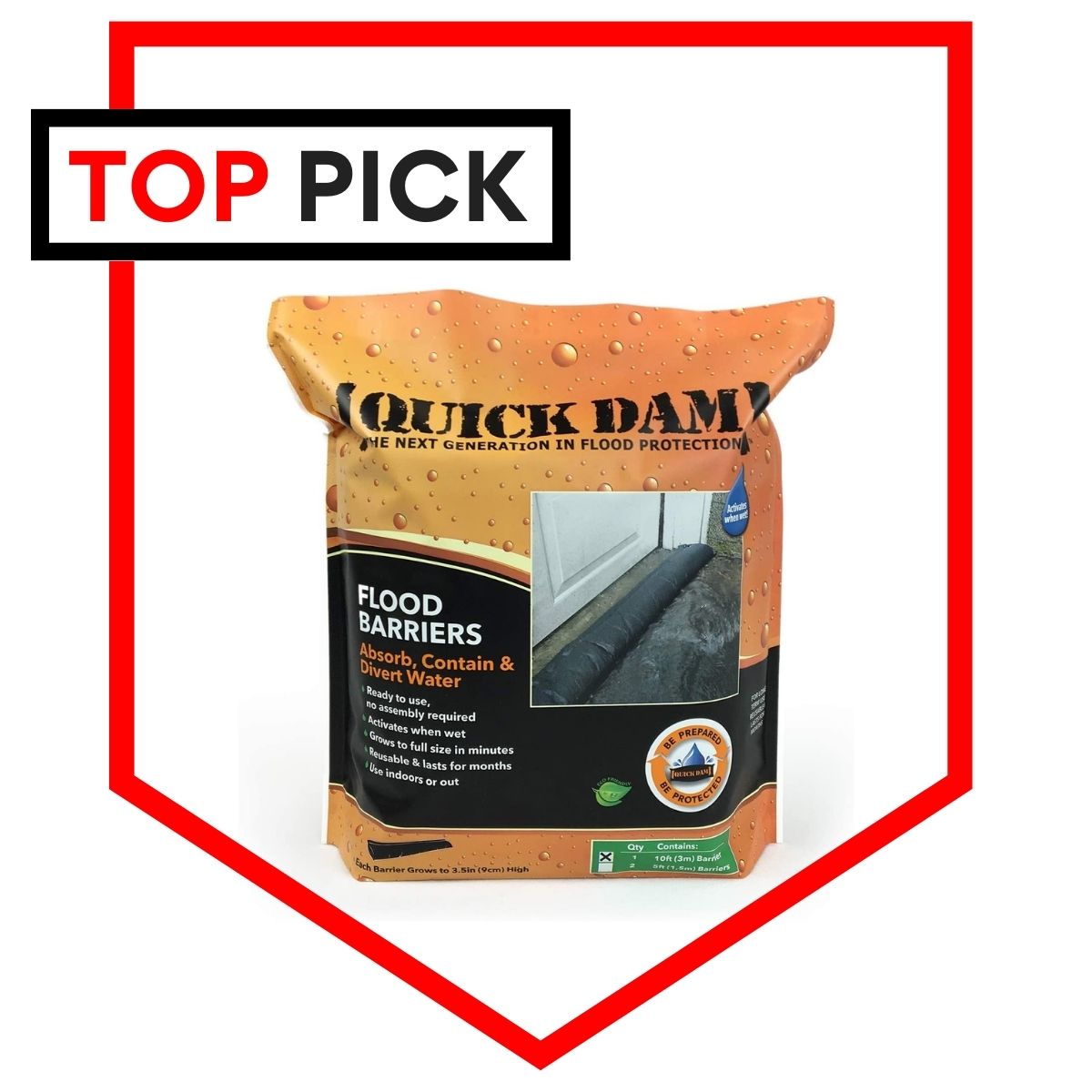
These water-activated pigs are great at quickly fortifying doorways from rising water.
Where to Buy
*at time of reviewing
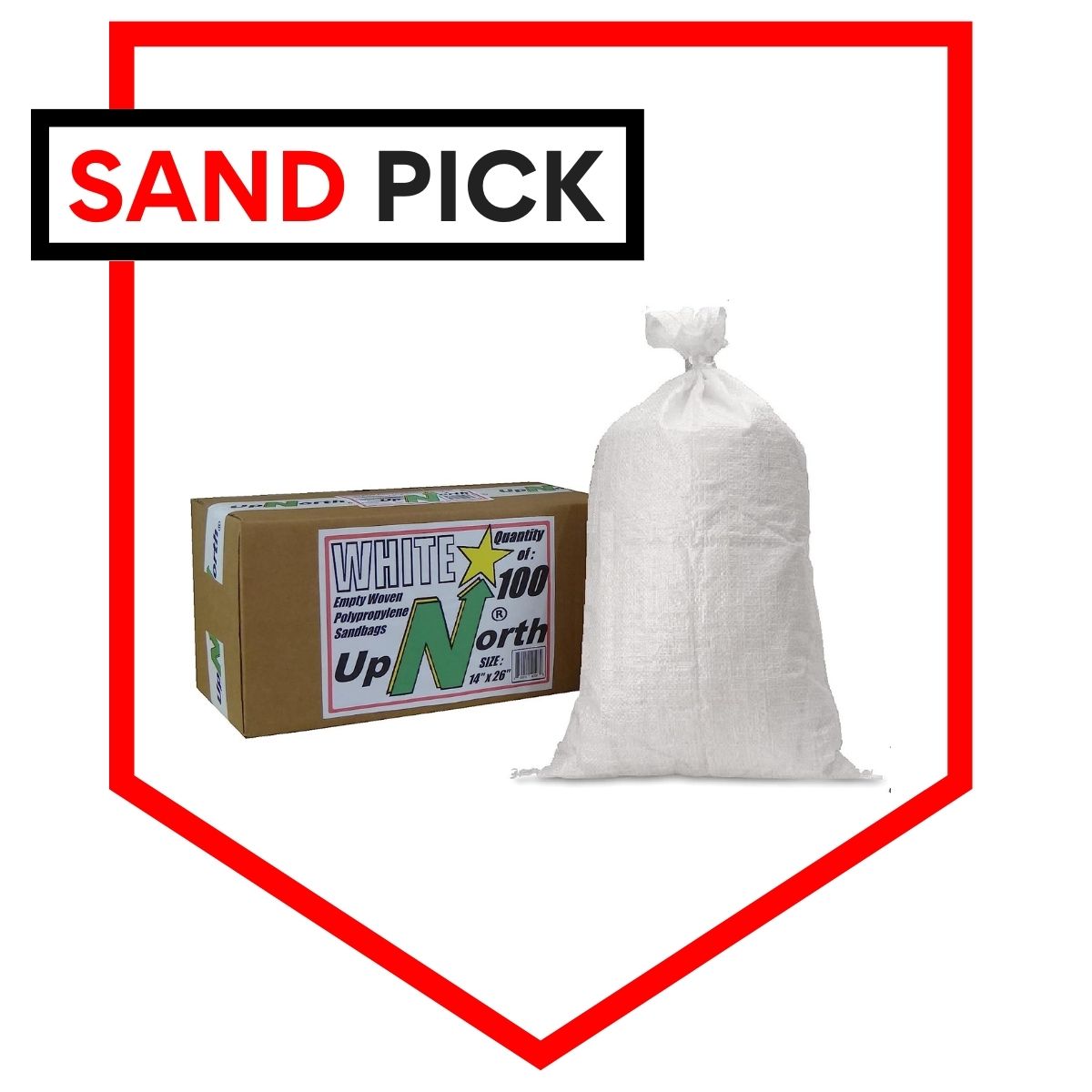
Sandbags have been the go-to for flood prevention for years, and these bags are simply the best bang for your buck.
Where to Buy
*at time of reviewing
The Barriers We Compared
Our research narrowed the field down to several brands and types of flood barriers that we compared: Quick Dam, Garrison, Osmo, Up North, Floodworx, Dam Easy, AquaSafe, and more.
You can see our full list of review criteria below in the What to Look For section, with an explanation for each.
We considered a wide range of flood management gear but ended up comparing portable flood barriers rather than installed or permanent fixtures. While those are great for storm situations, we simply wanted to compare apples to apples for the sake of our review. Leave us a note if you’d like us to dig deeper into installed door barriers, etc.
We’re always looking for new and better gear, so if you have a barrier that you swear by, let us know in the comments. We review most of our tested gear annually so we can try to get it in the next roundup round and see if it will beat out our top picks.
What to Look For
The best flood barriers have several important features to look for:
- Value
- Effectiveness
- Deployment Time
- Size & Coverage
- Storability
When you get the right blend of these, you can find a barrier that you can rely on in any flooding event. Below, we break down what each of these features means for the flood barriers that truly set themselves apart.
Value: Cost vs. Benefit
The amount of money you spend on something like a flood barrier shouldn’t blow out your entire budget. There is a wide range of price points when it comes to flood barriers mostly related to their versatility and deployment speed.
You never want to spend too much money on one thing when it comes to preparedness. It’s better to diversify your gear and budget to make sure you are covered for a wide range of scenarios.
Effectiveness
The barriers that we suggest are extremely effective when used appropriately. There are many other flood barriers we encountered that do a pretty good job but had leaks at attachment points and made for better water diverters than flood barriers.
Those can obviously be useful, but we were looking for solutions that you could trust to not leak.
Deployment Time
Deployment time is something to consider when you are getting a flood barrier, but it’s not necessarily a deal-breaker. Sandbags take a much longer time than anyone ever anticipates to fill, but flooding isn’t always by surprise. If you’ve done your homework and know that you live in a flood-prone area then you may be able to have plenty of notice for flooding events, like hurricanes.
Some other dams that do not self-activate missed our suggestion list because they took a long time to fill with water.
If flash floods are your threat, you may want to pre-fill things like sandbags and expose self-activating dams to water ahead of time so they absorb their height quickly.
Size & Coverage
Flood barriers cover a wide range of scenarios, from simple door dams all the way to 10′ high installed water diversion systems. The size of the dam and coverage you’ll need for your home varies for each individual scenario.
It’s something you’ll need to consider and we can’t really suggest anything specifically without knowing your flood map and your property.
Storability
A few of our picks are reusable and can be stored away during the dry seasons. This is great if you plan on needing it for more than just anticipating an emergency flood. If you do have recurring drainage and flooding issues, you may need to look at more robust water management for your property and make some long-term changes.
How to Use a Flood Barrier
Quick-deployment flood barriers are simple to use and easy to set up.
Sandbags, however, take a little more patience and planning to get right.
You don’t have to wear all the PPE these Aussies do, but they do a great job of showing how to set up sandbags for a variety of flood barrier uses:
Property Flood Protection Tips
The intensity of storms is increasing, and that means more rainwater filling up our storm drains. All of that rainwater has to go somewhere, so how do you keep that water from flooding your property? Once rain hits the ground and starts to flow, it’s called stormwater.
Stormwater causes all kinds of problems, from flooding property to contaminating drinking water. Here are some tips to help protect your property from floods caused by stormwater.
Remember how water flows
Water always follows the path of least resistance, and that’s usually downhill. The goal is to adjust that path to move the water away from valuables. You usually won’t be able to completely stop flowing stormwater, so focus on routing stormwater to areas that drain well and won’t flood your house or your neighbor’s house.
Check your insurance policy
Make sure you know if your insurance covers property damage from water run-off. Most policies (including flood insurance!) do not cover “ground-water runoff”, also known as stormwater runoff. Homeowners often don’t see the distinction, but most insurance companies call it a flood only if it comes out of a body of water.
Disconnect impervious surfaces
Impervious surfaces, like driveways, roads, and roofs don’t let rain soak in. Any rain that falls on these impervious surfaces runs off, and this is the water that will cause you the most problems. Do your best to limit the amount of runoff from impervious surfaces that drain to other impervious surfaces. Do this by diverting your gutter downspouts from impervious surfaces to areas that let the water drain into the ground (and away from your house!) like your yard or a garden.
You can also divert flow into a rain garden, which is a garden that’s purpose is to store and soak up stormwater. You can do some research to see what plants are best for a rain garden in your specific area. Plants love water, so let plants do the work for you and help with your flooding problem!
Use drains that work
Place drains around impervious surfaces that flood often. If possible, use a drain leading to a corrugated pipe with a fabric sock on it and with 10” of gravel on all sides. This allows drainage until capacity, and then the excess water will runoff.
If there is a possibility of that setup clogging, use a drain going into a 3” or 4” PVC pipe that drains to a safe collection area. Remember to clear drains and the area upstream from drains before a storm.
Natural adjustments
If the volume of stormwater is high, place water breaks where possible that divert water paths sideways and slightly downhill rather than straight downhill. You can see this in action on many unpaved paths on hiking trails.
In that scenario, trail builders use landscape timbers to channel water at an angle. This lowers erosion and diverts flow. A homeowner can use any wood, including boards, logs, or tree limbs to do the same.
Make adjustments while it’s happening
Go outside when it rains (not during dangerous storms!) and watch where the water goes. If you make an adjustment then, you can see immediate results! Work your way along the flow until the new path is running well, or just mark areas to work on later after it’s done raining.
Flowing water is extremely powerful, and it’ll flow where it wants based on the lay of the land. Use these tips to help it make up its mind. With some water management, you can spare your valuable property from costly and time-consuming water damage.
Who Needs a Flood Barrier?
Not everyone needs a flood barrier, but it is a good idea to do the research to see if you do. The first step is checking your flood map:
- FEMA Flood Maps (flood zone designations for predictions and insurance)
- USGS National Water Dashboard (for real-time flood monitoring)
If you are in an at-risk area on the map, you should consider a flood barrier for your:
Some flood barriers, like pigs and sandbags, can also be useful in other water mitigation situations, or as barriers for other events (especially sandbags).
How We Review Products: We research thoroughly before selecting the best products to review. We have vast prepping and survival experience and bring in outside experts when needed. Hours on end are spent testing gear in stressful conditions and using specialized testing gear to verify claims. We assign performance criteria and impartially rate each tested item. Learn more about how we test.
Sources and References
All of our experience and the testing we do to determine the best flood barrier are useless without listing our research sources and references. We leaned on these for the book knowledge that we paired with our hands-on testing and practical survival experience:
McCormack, S., et al. (2012). Temporary Flood Barriers. Kentucky Transportation Center. (Source)
Nofal, O., et al. (2021). Modeling the Impact of Building-Level Flood Mitigation Measures Made Possible by Early Flood Warnings on Community-Level Flood Loss Reduction. Buildings. Volume 11. Issue 10. Pages 475. (Source)
Zhegang, D., et al. (2022). Research to Develop Flood Barrier Testing Strategies for Nuclear Power Plants. U.S. Department of Energy; Office of Scientific and Technical Information. (Source)
The Final Word
When a hurricane, severe storm, or storm surge comes knocking- you’ll be glad to have a portable flood barrier ready to go. Flooding is one of the deadliest natural disasters and can quickly rack up billions in damages. Many people underestimate flooding as a potential threat and insurance carriers don’t cover it in typical home insurance.
Here are a few other guides and reviews our subscribers have found helpful:
- The Best Survival Tarp for Prepping and Emergencies
- Best Water Purification Tablets
- Home Survival Kit List | 53 Essentials
We presented quite a lot of information, but as always: if you have any questions let us know and we would be happy to help. Our research and testing found the Quick Dam Water-Activated Flood Barrier to be the best option given its value, effectiveness, deployment time, size/coverage, and storability.
Keep exploring, stay prepared, and be safe.
You’ve Been Missing Out
Join the 2+ million preppers that rely on our prepping advice by subscribing to TruePrepper.- Practical guides and tips
- Useful survival giveaways
- Free, forever
- < 0.4% of people unsubscribe
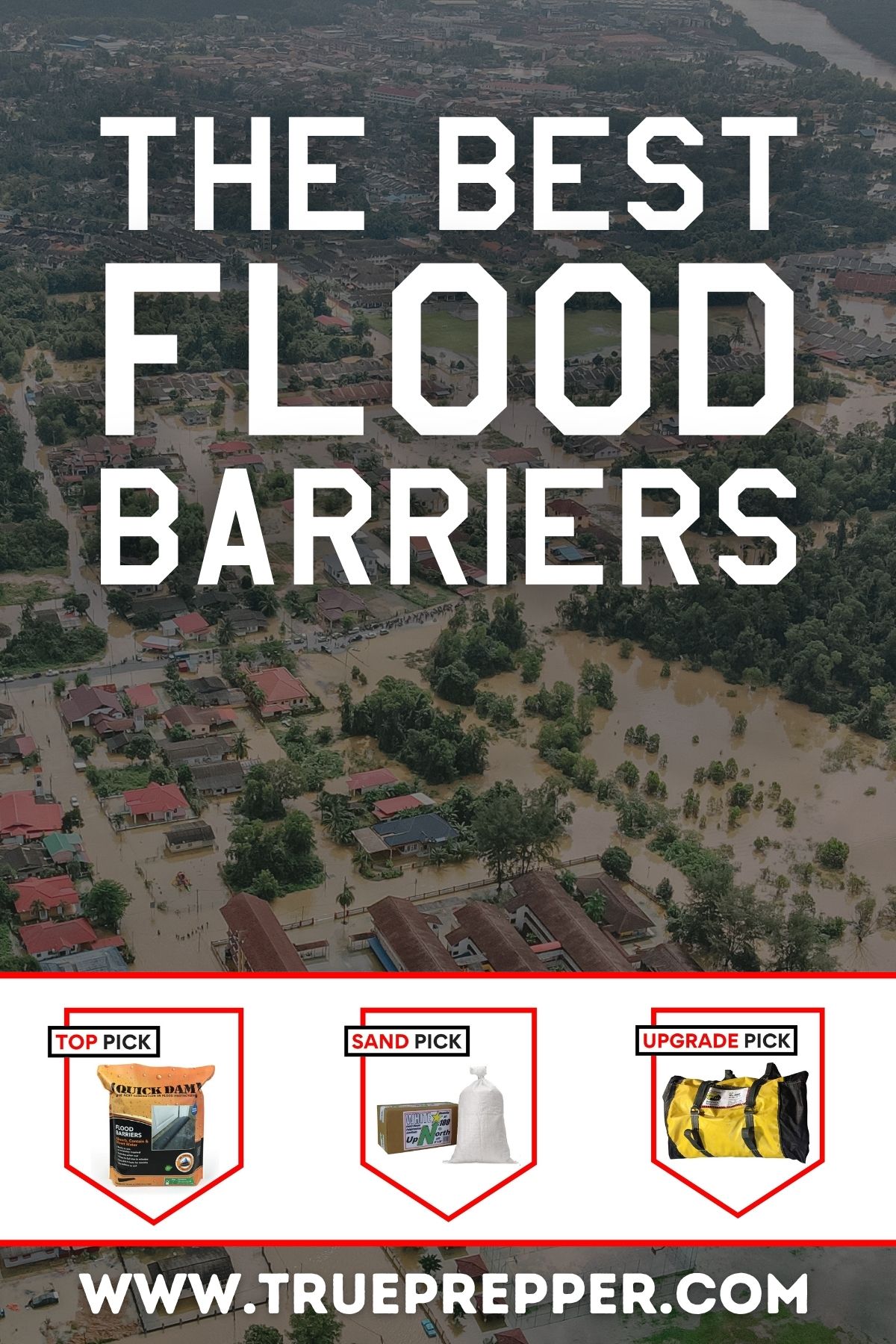

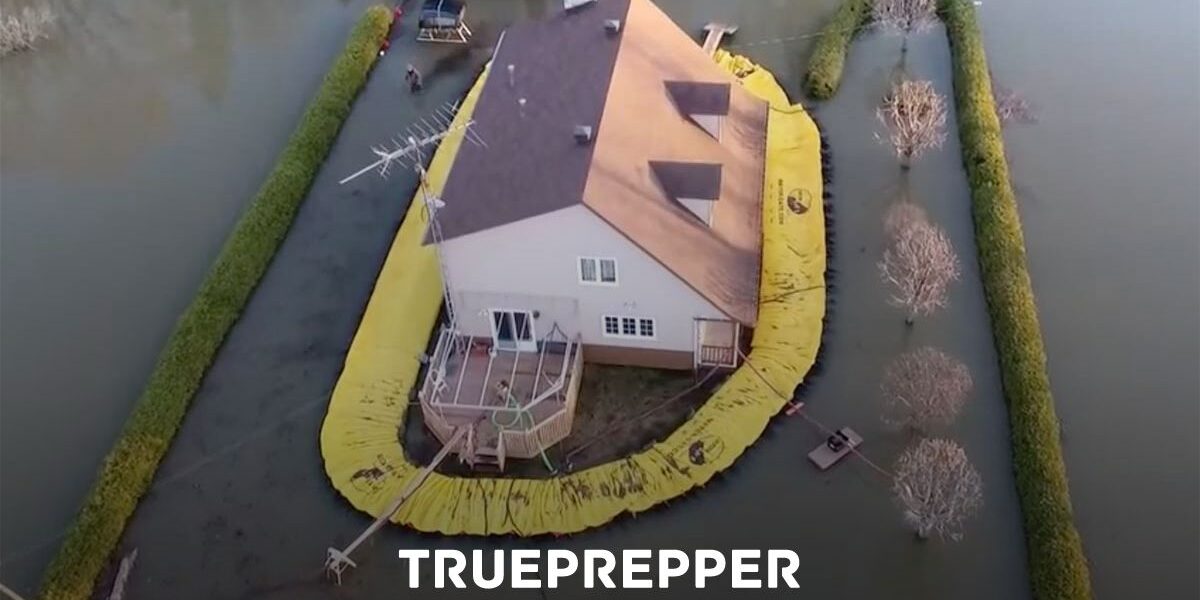
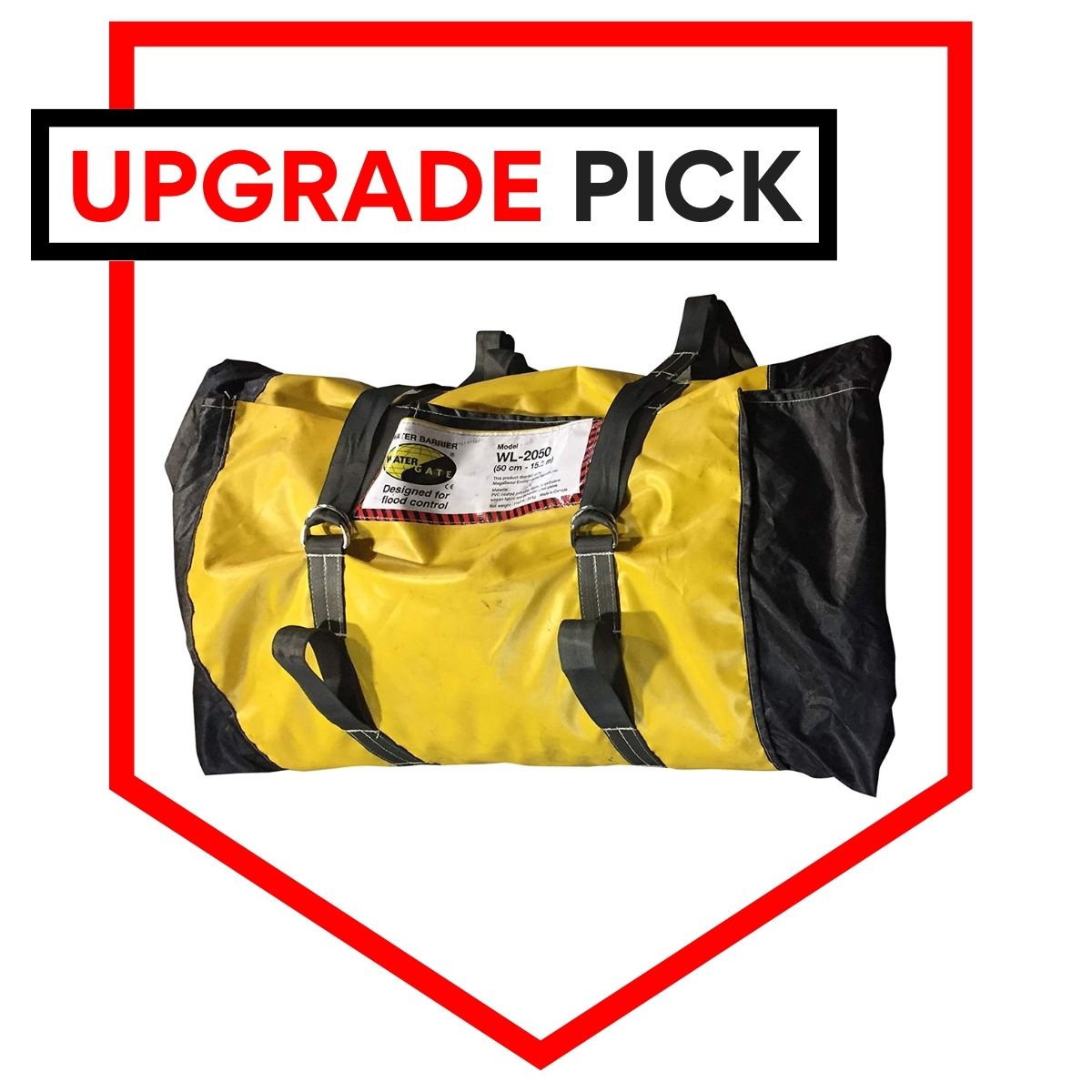
It really helped when you elaborated on flood barriers and what we’d look for when shopping for one. Last year, my parents’ house flooded during a hurricane, so we want to prevent that from happening again. Their house is located in a flood zone, so I’ll suggest we look for sandbags with the right size and coverage.